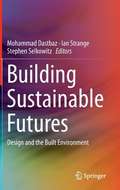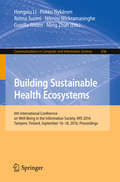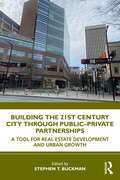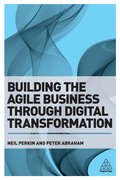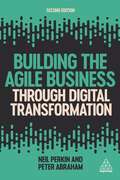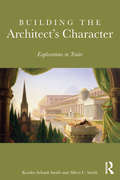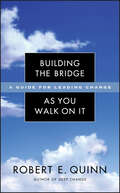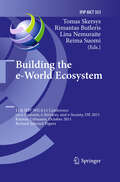- Table View
- List View
Building Sustainable Competitive Advantage: Through Executive Enterprise Leadership
by Dhirendra KumarIn Building Sustainable Competitive Advantage Dhirendra Kumar shows how the Enterprise Excellence (EE) philosophy is a holistic approach for leading an enterprise to total excellence. It does this by focussing on achieving sustainable significant growth in revenue and profitability, reducing the business cycle time, strategically managing the enterprise risk and focusing on the needs of the customer. There may be various organizations within an enterprise but they must all focus on meeting or exceeding customer needs. Therefore, EE is an integrated approach affecting every employee, every functional area and strategy within the organization. Enterprise risk must be identified, assessed and prioritized; developing a growth strategy proposal which leadership has to execute in order to achieve goals. As business leaders spearhead the efforts, they must minimize, monitor and control the probability and/or impact of unfortunate events and maximize the realization of opportunities. The achievements in Enterprise Excellence can range from greater cost efficiencies, improved market perceptions, fundamental changes to markets, to new product and service offerings. There may also be significant upgrades in skills, technology, and business strategies. The scope of Enterprise Excellence can also range from operations activities, to business functions, to overall organization and to the enterprise as a whole. Building Sustainable Competitive Advantage is a comprehensive reference book for practising professionals, teaching faculty, and students alike.
Building Sustainable Couples in International Relations: A Strategy Towards Peaceful Cooperation
by Brigitte Vassort-RoussetThe contributors investigate processes of international conflict transformation and peaceful cooperation. They highlight how critical intermediary-level components have proved more conducive to promoting rapprochement between rival states than interstate diplomatic engagement through incremental identity-change.
Building Sustainable Futures: Design and the Built Environment
by Mohammad Dastbaz Jon Price Ian Strange Stephen SelkowitzThis book presents state-of-the-art research and case studies on new approaches to the design, construction and planning of our cities. Emphasis is placed on the role of alternative and renewable energy in the development of urban infrastructures that enable sustainable futures. Reflecting the multi-faceted efforts required to successfully meet sustainability challenges, this book is a collaboration between practitioners and academics across a broad spectrum of specializations. Compelling research findings are explained in the context of practical implementation, enhanced by case studies from industry leaders in order to create a pragmatic reference across policy areas where environmentally aware decision making is required.
Building Sustainable Futures: Design and the Built Environment (PDF)
by Mohammad Dastbaz Jon Price Ian Strange Stephen SelkowitzThis book presents state-of-the-art research and case studies on new approaches to the design, construction and planning of our cities. Emphasis is placed on the role of alternative and renewable energy in the development of urban infrastructures that enable sustainable futures. Reflecting the multi-faceted efforts required to successfully meet sustainability challenges, this book is a collaboration between practitioners and academics across a broad spectrum of specializations. Compelling research findings are explained in the context of practical implementation, enhanced by case studies from industry leaders in order to create a pragmatic reference across policy areas where environmentally aware decision making is required.
Building Sustainable Health Ecosystems: 6th International Conference on Well-Being in the Information Society, WIS 2016, Tampere, Finland, September 16-18, 2016, Proceedings (Communications in Computer and Information Science #636)
by Hongxiu Li Pirkko Nykänen Reima Suomi Nilmini Wickramasinghe Gunilla Widén Ming ZhanThis book constitutes the refereed proceedings of the 6th International Conference on Well-Being in the Information Society, WIS 2016, held in Tampere, Finland, in September 2016. The 21 revised full papers presented were carefully reviewed and selected from 42 submissions. With the core topic "Building Sustainable Health Ecosystems" WIS 2016 focused on innovations and fresh ideas in the cross-section of urban living, information society and health as understood in a wide sense. The papers presented in this volume are organized along the following seven broad topics: 1. Macro level considerations of e-health and welfare, 2.Welfare issues of children, youth, young elderly and seniors, 3. Analytics issues of eHealth and welfare, 4. National/regional initiatives in eHealth and welfare, and 5. Specific topics of eHealth. The papers in these topics span qualitative and quantitative analysis, empirical surveys, case studies as well as conceptual work.
Building Sustainable Leadership from the Inside: How To Grow The Inner Capabilities We Need To Lead
by Joakim ErikssonDrawing on contemporary neuroscience, this book shows leaders how they can literally train their mind to become more resilient and have a more sustainable impact.This is a research‑backed and practical guide for how to grow inner capabilities enabling sustainable leadership in this time. It is built around five areas that many leaders will recognize as being challenging on a personal level, such as how to stay calm under pressure, navigate in uncertainty or collaborate skilfully with people with diverse points of views. While many leadership books describe the importance of such traits, few show how to actually cultivate them. Grounded in multiple fields of research, this book offers a practical training manual for the mind. With more than 40 reflections and exercises, it offers a guided tour to an ‘inner gym’, showing readers how to cultivate these capabilities.Leaders who have realized that it takes more than IQ and theoretical knowledge to create sustainable impact and are looking for ways to deepen their leadership capacity and authenticity will find them in this practical training manual for the mind.
Building Sustainable Leadership from the Inside: How To Grow The Inner Capabilities We Need To Lead
by Joakim ErikssonDrawing on contemporary neuroscience, this book shows leaders how they can literally train their mind to become more resilient and have a more sustainable impact.This is a research‑backed and practical guide for how to grow inner capabilities enabling sustainable leadership in this time. It is built around five areas that many leaders will recognize as being challenging on a personal level, such as how to stay calm under pressure, navigate in uncertainty or collaborate skilfully with people with diverse points of views. While many leadership books describe the importance of such traits, few show how to actually cultivate them. Grounded in multiple fields of research, this book offers a practical training manual for the mind. With more than 40 reflections and exercises, it offers a guided tour to an ‘inner gym’, showing readers how to cultivate these capabilities.Leaders who have realized that it takes more than IQ and theoretical knowledge to create sustainable impact and are looking for ways to deepen their leadership capacity and authenticity will find them in this practical training manual for the mind.
Building Sustainable Peace: Timing and Sequencing of Post-Conflict Reconstruction and Peacebuilding
by Arnim Langer Graham K. BrownCountries emerging from civil war or protracted violence often face the daunting challenge of rebuilding their economy while simultaneously creating the political and social conditions for a stable peace. The implicit assumption in the international community that rapid political democratisation along with economic liberalisation holds the key to sustainable peace is belied by the experiences of countries such as Iraq and Afghanistan. Often, the challenges of post-conflict reconstruction revolve around the timing and sequencing of different reform that may have contradictory implications. Drawing on a range of thematic studies and empirical cases, this book examines how post-conflict reconstruction policies can be better sequenced in order to promote sustainable peace. The book provides evidence that many reforms that are often thought to be imperative in post-conflict societies may be better considered as long-term objectives, and that the immediate imperative for such societies should be 'people-centred' policies.
Building Sustainable Peace: Timing and Sequencing of Post-Conflict Reconstruction and Peacebuilding
Countries emerging from civil war or protracted violence often face the daunting challenge of rebuilding their economy while simultaneously creating the political and social conditions for a stable peace. The implicit assumption in the international community that rapid political democratisation along with economic liberalisation holds the key to sustainable peace is belied by the experiences of countries such as Iraq and Afghanistan. Often, the challenges of post-conflict reconstruction revolve around the timing and sequencing of different reform that may have contradictory implications. Drawing on a range of thematic studies and empirical cases, this book examines how post-conflict reconstruction policies can be better sequenced in order to promote sustainable peace. The book provides evidence that many reforms that are often thought to be imperative in post-conflict societies may be better considered as long-term objectives, and that the immediate imperative for such societies should be 'people-centred' policies.
Building Tall: My Life and the Invention of Construction Management
by John L Tishman Tom Shachtman"John Tishman is a true pioneer in the Construction Management industry. Through his CM leadership, some of America's most well-known buildings have been brought to successful completion." ---Bruce D'Agostino, president and chief executive, Construction Management Association of America "Building Tall will provide readers with insights into John Tishman's career as a visionary engineer, landmark builder, and great businessman. Responsible for some of the construction world's most magnificent projects, John is one of the preeminent alumni in the history of Michigan Engineering. His perspectives have helped me throughout my time as dean, and his impact will influence generations of Construction Management professionals and students." ---David C. Munson, Jr., Robert J. Vlasic Dean of Engineering, University of Michigan In this memoir, University of Michigan graduate John L. Tishman recounts the experiences and rationale that led him to create the entirely new profession now recognized and practiced as Construction Management. It evolved from his work as the construction lead of the "owner/builder" firm Tishman Realty and Construction, and his personal role as hands-on Construction Manager in the building of an astonishing array of what were at the time the world's tallest and most complex projects. These include The world's first three 100-story towers---the original "twin towers" of the World Trade Center in Manhattan and the Hancock Tower in Chicago. The Epcot Center at Disney World. The Renaissance Center in Detroit. New York's Madison Square Garden. Tishman interweaves the stories behind the construction of these and many other important buildings and projects with personal reminiscences of his dealings with Henry Ford, Jr., Disney's Michael Eisner, casino magnate Steve Wynn, and many others into a practical history of the field of Construction Management, which he pioneered. This book will be of interest not only to a general public interested in the stories and personalities behind many of the most iconic construction projects of the post–World War II period in the United States but to students of engineering and architecture and members of the new field of Construction Management.
Building Telecom Markets: Evolution of Governance in the Korean Mobile Telecommunication Market (The Political Economy of the Asia Pacific)
by Whasun JhoThe mobile telecommunication industry has been one of the fastest growing industries in the global economy since the late 1990s. As the first country to offer commercial Code Division Multiple Access (CDMA) cellular service in the world, Korea was able to jump right into the digital mobile markets, enhancing its status as a leading manufacturer of mobile equipment. While the growth of the telecom industry occurred with the emergence of worldwide market-oriented regulatory reform and liberalization in telecommunications, the state-market relationship in Korea evolved from state monopoly toward “centralized governance” and later toward “flexible governance,” which is substantially different from “liberal governance” of the US. This book examines the uniqueness of Korean regulatory reforms of the mobile telecommunication sector, and argues that the market-oriented regulatory reform and liberalization should be explained by focusing on the interactions among the state, the private sector, and international political economic environment. It will appeal to scholars and policy-makers alike concerned with market regulation, Asian development and political economy.
Building the 21st Century City through Public-Private Partnerships: A Tool for Real Estate Development and Urban Growth
by Stephen T. BuckmanBuilding the 21st Century City through Public-Private Partnerships introduces students and early-career professionals to the fundamentals of this unique form of cross-sector collaboration. From understanding the responsibilities of government and industry partners to stewardship of taxpayer dollars, this introductory guide empowers developers and local officials to deliver successful commercial, leisure, and industrial projects neither could undertake on their own. Chapters on securing financing and navigating permitting processes demystify the steps to creating profitable developments, while case studies from around the United States provide invaluable local context. A glossary of public–private partnership terminology offers the reader an insider’s grasp of the language of government and industry partnerships. Equips developers and local officials with the foundations for successful collaboration Provides a template for building effective public–private partnerships in every area of real estate development Includes field-tested insights from case studies of diverse public–private partnership examples Ideal reading for courses in public administration, city planning, real estate, not-for-profit studies, public service, and more Helmed by a practitioner turned academic, Building the 21st Century City through Public–Private Partnerships serves as a masterclass with veteran developers, planners, municipal officials, and scholars.
Building the 21st Century City through Public-Private Partnerships: A Tool for Real Estate Development and Urban Growth
Building the 21st Century City through Public-Private Partnerships introduces students and early-career professionals to the fundamentals of this unique form of cross-sector collaboration. From understanding the responsibilities of government and industry partners to stewardship of taxpayer dollars, this introductory guide empowers developers and local officials to deliver successful commercial, leisure, and industrial projects neither could undertake on their own. Chapters on securing financing and navigating permitting processes demystify the steps to creating profitable developments, while case studies from around the United States provide invaluable local context. A glossary of public–private partnership terminology offers the reader an insider’s grasp of the language of government and industry partnerships. Equips developers and local officials with the foundations for successful collaboration Provides a template for building effective public–private partnerships in every area of real estate development Includes field-tested insights from case studies of diverse public–private partnership examples Ideal reading for courses in public administration, city planning, real estate, not-for-profit studies, public service, and more Helmed by a practitioner turned academic, Building the 21st Century City through Public–Private Partnerships serves as a masterclass with veteran developers, planners, municipal officials, and scholars.
Building the Agile Business through Digital Transformation
by Neil Perkin Peter AbrahamBuilding the Agile Business through Digital Transformation is an in-depth look at transforming businesses so they are fit for purpose in a digitally enabled world. It is a guide for all those needing to better understand, implement and lead digital transformation in the workplace. It sets aside traditional thinking and outdated strategies to explain what steps need to be taken for an organization to become truly agile. It addresses how to build organizational velocity and establish iterative working, remove unnecessary process, embed innovation, map strategy to motivation and develop talent to succeed. Building the Agile Business through Digital Transformation provides guidance on how to set the pace and frequency for change and shows how to break old habits and reform the behaviours of a workforce to embed digital transformation, achieve organizational agility and ensure high performance. Full of practical advice, examples and real-life insights from organizational development professionals at the leading edge of digital transformation, this book is an essential guide to building an agile business.
Building the Agile Business through Digital Transformation
by Neil Perkin Peter AbrahamBuilding the Agile Business through Digital Transformation is an in-depth look at transforming businesses so they are fit for purpose in a digitally enabled world. It is a guide for all those needing to better understand, implement and lead digital transformation in the workplace. It sets aside traditional thinking and outdated strategies to explain what steps need to be taken for an organization to become truly agile. It addresses how to build organizational velocity and establish iterative working, remove unnecessary process, embed innovation, map strategy to motivation and develop talent to succeed. Building the Agile Business through Digital Transformation provides guidance on how to set the pace and frequency for change and shows how to break old habits and reform the behaviours of a workforce to embed digital transformation, achieve organizational agility and ensure high performance. Full of practical advice, examples and real-life insights from organizational development professionals at the leading edge of digital transformation, this book is an essential guide to building an agile business.
Building the Agile Business through Digital Transformation
by Neil Perkin Peter AbrahamHow can businesses transform to achieve competitive advantage in a digital-enabled world? How can managers and leaders create a culture that supports lasting change through these transformations?Building the Agile Business through Digital Transformation is an in-depth guide for all those needing to better understand, implement and lead digital transformation in the workplace. It sets aside traditional thinking and outdated strategies to explain what steps need to be taken for an organization to become truly agile, embed innovation and develop talent to succeed.This majorly revised second edition of Building the Agile Business through Digital Transformation contains new material on the culture and mindset challenges of shifting at scale from linear to agile working, and using data effectively in organizational decision-making. Full of practical advice, examples and real-life insights from organizations at the leading edge of digital transformation including AirBnb, Amazon and Google, this book is an essential guide to driving success by becoming an agile and digital native business.
Building the Agile Enterprise: With SOA, BPM and MBM (The MK/OMG Press)
by Fred A. CumminsIn the last ten years IT has brought fundamental changes to the way the world works. Not only has it increased the speed of operations and communications, but it has also undermined basic assumptions of traditional business models and increased the number of variables. Today, the survival of major corporations is challenged by a world-wide marketplace, international operations, outsourcing, global communities, a changing workforce, security threats, business continuity, web visibility, and customer expectations. Enterprises must constantly adapt or they will be unable to compete. Fred Cummins, an EDS Fellow, presents IT as a key enabler of the agile enterprise. He demonstrates how the convergence of key technologies—including SOA, BPM and emerging enterprise and data models—can be harnessed to transform the enterprise. Cummins mines his 25 years experience to provide IT leaders, as well as enterprise architects and management consultants, with the critical information, skills, and insights they need to partner with management and redesign the enterprise for continuous change. No other book puts IT at the center of this transformation, nor integrates these technologies for this purpose.Shows how to integrate and deploy critical technologies to foster agilityDetails how to design an enterprise architecture that takes full advantage of SOA, BPM, business rules, enterprise information management, business models, and governanceOutlines IT's critical mission in providing an integration infrastructure and key services, while optimizing technology adoption throughout the enterpriseIllustrates concepts with examples and cases from large and small commercial enterprisesShows how to create systems that recognize and respond to the need for changeIdentifies the unique security issues that arise with SOA and shows how to deploy a framework of technologies and processes that address them
Building the Architect's Character: Explorations in Traits
by Kendra Schank Smith Albert C. SmithAn understanding of architects’ character traits can offer important insights into how they design buildings. These traits include leadership skills necessary to coordinate a team, honest and ethical behavior, being well educated and possessing a life-long love of learning, flexibility, resourcefulness, and visionary and strategic thinking. Characteristics such as these describe a successful person. Architects also possess these traits, but they have additional skills specifically valuable for the profession. These will include the ability to question the use of digital media, new materials, processes, and methods to convey meaning in architectural form. Although not exhaustive, a discussion of such subjects as defining, imaging, persuading, and fabricating will reveal representational meaning useful for the development of an understanding of architects’ character. Through the analogies and metaphors found in Greek myth, the book describes the elusive, hard-to-define characteristics of architects to engage the dilemmas of a changing architectural landscape. Building the Architect’s Character: Explorations in Traits examines traditional and archetypal characteristics of the successful architect to ask if they remain relevant today.
Building the Architect's Character: Explorations in Traits
by Kendra Schank Smith Albert C. SmithAn understanding of architects’ character traits can offer important insights into how they design buildings. These traits include leadership skills necessary to coordinate a team, honest and ethical behavior, being well educated and possessing a life-long love of learning, flexibility, resourcefulness, and visionary and strategic thinking. Characteristics such as these describe a successful person. Architects also possess these traits, but they have additional skills specifically valuable for the profession. These will include the ability to question the use of digital media, new materials, processes, and methods to convey meaning in architectural form. Although not exhaustive, a discussion of such subjects as defining, imaging, persuading, and fabricating will reveal representational meaning useful for the development of an understanding of architects’ character. Through the analogies and metaphors found in Greek myth, the book describes the elusive, hard-to-define characteristics of architects to engage the dilemmas of a changing architectural landscape. Building the Architect’s Character: Explorations in Traits examines traditional and archetypal characteristics of the successful architect to ask if they remain relevant today.
Building the Bridge As You Walk On It: A Guide for Leading Change (J-B US non-Franchise Leadership #347)
by Robert E. QuinnBuilding the Bridge As You Walk On It tells the personal stories of people who have embraced deep change and inspired author Robert Quinn to take his concept one step further and develop a new model of leadership—“the fundamental state of leadership.” The exploration of this transformative state is at the very heart of the book. Quinn shows how anyone can enter the fundamental state of leadership by engaging in the eight practices that center on the theme of ever-increasing integrity—reflective action, authentic engagement, appreciative inquiry, grounded vision, adaptive confidence, detached interdependence, responsible freedom, and tough love. After each chapter, Quinn challenges you to assess yourself with respect to each practice and to formulate a strategy for personal growth.
Building the Bridge As You Walk On It: A Guide for Leading Change (J-B US non-Franchise Leadership #204)
by Robert E. QuinnBuilding the Bridge As You Walk On It tells the personal stories of people who have embraced deep change and inspired author Robert Quinn to take his concept one step further and develop a new model of leadership—“the fundamental state of leadership.” The exploration of this transformative state is at the very heart of the book. Quinn shows how anyone can enter the fundamental state of leadership by engaging in the eight practices that center on the theme of ever-increasing integrity—reflective action, authentic engagement, appreciative inquiry, grounded vision, adaptive confidence, detached interdependence, responsible freedom, and tough love. After each chapter, Quinn challenges you to assess yourself with respect to each practice and to formulate a strategy for personal growth.
Building the Digital Enterprise: A Guide to Constructing Monetization Models Using Digital Technologies (Business in the Digital Economy)
by Mark SkiltonThe digital economy is at a tipping point. This practical book defines digital ecosystems, discusses digital design using converging technologies of social networking, mobility, big data and cloud computing, and provides a methods for linking digital technologies together to meet the challenges of building a digital enterprise in the new economy.
Building the E-Service Society: E-Commerce, E-Business, and E-Government (IFIP Advances in Information and Communication Technology #146)
by Winfried Lamersdorf Volker Tschammer Stephane AmargerBuilding the E-Service Society is a state-of-the-art book which deals with innovative trends in communication systems, information processing, and security and trust in electronic commerce, electronic business, and electronic government. It comprises the proceedings of I3E2004, the Fourth International Conference on E-Commerce, E-Business, and E-Government, which was held in August 2004 as a co-located conference of the 18th IFIP World Computer Congress in Toulouse, France, and sponsored by the International Federation for Information Processing (IFIP). The book contains recent results and developments in the following areas: E-Government:E-Government Models and Processes,E-Governance,Service Provisioning. E-Business:Infrastructures and Marketplaces,M-Commerce,Purchase and Payment. E-Commerce:Value Chain Management,E-Business Architectures and Processes,E-Business Models.
Building the e-World Ecosystem: 11th IFIP WG 6.11 Conference on e-Business, e-Services, and e-Society, I3E 2011, Kaunas, Lithuania, October 12-14, 2011, Revised Selected Papers (IFIP Advances in Information and Communication Technology #353)
by Tomas Skersys Rimantas Butleris Lina Nemuraite Reima SuomiThis book constitutes the thoroughly refereed post-conference proceedings of the 11th IFIP WG 6.11 Conference on e-Business, e-Services and e-Society, I3E 2011, held in Kaunas, Lithuania, in October 2011. The 25 revised papers presented were carefully reviewed and selected from numerous submissions. They are organized in the following topical sections: e-government and e-governance, e-services, digital goods and products, e-business process modeling and re-engineering, innovative e-business models and implementation, e-health and e-education, and innovative e-business models.
Building the Future with Human Resource Management (Management and Industrial Engineering)
by Carolina MachadoThis book explores the dynamic landscape of contemporary organizations, navigating through topics such as innovation, creativity, emotional intelligence, technology, and sustainability. The book shows how high-skilled workers synergize with machines, emphasizing the evolving nature of work into a talent-centric domain. It delves into human resource management, offering a comprehensive understanding of its strategic significance in fostering innovative, creative, and socially responsible organizations. The chapters guide the reader through an array of topics, from technological trends in HRM to the ethical dimensions of responsible management and the strategic approach to fostering gender equality. Each chapter, authored by experts in management and engineering, serves as a beacon of knowledge, providing executives, managers, engineers, academics, and students with the essential tools and insights needed to propel organizations into the future.


